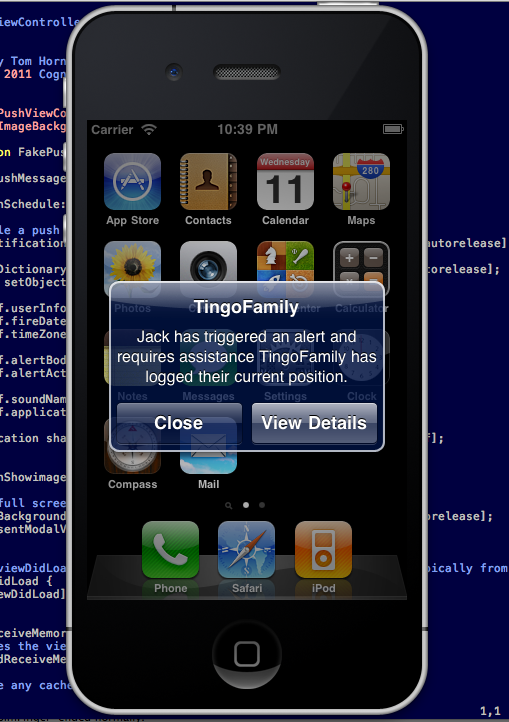What's wrong with Google Maps development on Android - Part Two

Update 5th December 2012 - Android Maps v2
A smaller issue with the Android maps library, but worth mentioning
When I started doing web development with the Google Maps API six years ago, it required an API key. You associated it with your domain and prevented naughty people from doing bad things with the API.
Times have changed. With version three, the key went away. The API was infinitely more awesome than the old one, and this was one tiny part of that. The old key was a little irritating if you had to move code between domains, so not having to worry about it made things that much easier for developers.
"The android:apiKey attribute holds the Maps API Key for your application, which proves your application and signer certificate has been registered with the Maps service. This is required in order to receive the map data, even while you are developing.
So you grab your Maps API key by taking an md5 hash of your signing certificate and submitting it to Google to get your key. There are a couple of things that make this annoying for developers:
- When you are debugging your application you use the SDK debug certificate, so you will need a different Google Maps key for your dev build.
- If you are building multiple applications from the same source code, then you are going to have to make sure you have an API key for each one and conditionally compile them in.
Admittedly these are pretty minor irritations, but when you consider that neither the iPhone MapKit or the web API require a key (and I realise there are technical differences here), it seems like an unnecessary one.
This rant continues:
- What's wrong with Google Maps development on Android - Part One
- What's wrong with Google Maps development on Android - Part Two
- What's wrong with Google Maps development on Android - Part Three
Permalink - Comments - Tags: Development,Android,Google
What's wrong with Google Maps development on Android - Part One

Update 5th December 2012 - Android Maps v2
This rant is coming from an unabashed Google fanboy. I have always loved Google as a company and the maps API in particular. I write this in the hope that it will help Android become a better place for developers like me.
Also, all the hard work for this post was done by Nick Maher. He blazed the Android development trail for me and most of the insights in this post are his. Some of the hoops that he has jumped through makes Tripview for Android even more impressive.
This fairly inocuous sentence in the Hello MapView tutorial hides a nasty underlying problem with the Google Maps library:
This is a special sub-class of Activity, provided by the Maps library, which provides important map capabilities.
Basically it means if you want to display a google map inside an activity in Android, you need to derive from the MapActivity class. So this isn't so bad right? Well maybe not.
What if you have an activity, GenericToolboxActivity, that does a bunch of different things, one of which involves displaying a map? Forcing GenericToolboxActivity to derive from MapActivity seems kinda dumb.
You can get around that problem by sticking your MapActivity in a LocalActivityManager. The LocalActivityManager is basically a sandbox for your activity. You stick your MapActivity subclass, let's call her JealousSpouseMapActivity, in your LocalActivityManager and gently prod her until she gives up that MapView object that you so desire:
// set up the LAM
m_lam = new LocalActivityManager(this, true);
// stick the map activity in the LAM
Intent intent = new Intent(this, JealousSpouseMapActivity.class);
m_lam.dispatchCreate(null);
m_lam.dispatchResume();
m_lam.startActivity("map", intent);
m_mapActivity = (JealousSpouseMapActivity)m_lam.getActivity("map");
// the view please?
return m_mapActivity.getWindow().getDecorView();
// Once I am finished with the view, clean it up
m_lam.dispatchPause(true);
m_lam.dispatchDestroy(true);
You are essentially lulling your JealousSpouseMapActivity into a false sense of security:
Dear JealousSpouseMapActivity, I would never re-parent any of your stuff. That would be wrong. Put your feet up and relax, i'll just need a pointer to your MapView before I pop off and get you breakfast in bed.
Once you have the MapView you can stick it in your view heirachy for your generic activity and JealousSpouseMapActivity is none the wiser. So why can't this stuff just be done in a MapView class instead? According to the MapActivity documentation its responsibilities include:
- Activity lifecycle managment - So presumably most activities need to manage their lifecycle, so I wonder how much map specific stuff is done here.
- Setup and teardown of services behind a MapView - Hrm. If we can have a WebView object that does requests in the background, fairly complex rendering and all sorts of other magical things, I wonder why we can't have a MapView that does the same. What is so "special" about a map that makes it impossible to implement as a view subclass.

In fact thinking about WebView brings up another argument against implementing the map this way. What if our helpful and friendly WebView had some kind of mental break and turned into AngryExGirlfriendWebActivity? What if we had to derive activies that show web content from AngryExGirlfriendWebActivity? If we want to show web and map content at the same time, basically we are screwed, we can't derive from them both. I guess we could try and stick both AngryExGirlfriendWebActivity and JealousSpouseMapActivity into a LocalActivityManager and then gently ask them to give up their respective view goodness, but I can't imagine that is going to end well.
Ok, Perhaps I have taken this analogy a little too far, but you get the idea.
This rant continues:
- What's wrong with Google Maps development on Android - Part One
- What's wrong with Google Maps development on Android - Part Two
- What's wrong with Google Maps development on Android - Part Three
Permalink - Comments - Tags: Development,Android,Google
iPhone apps and cappuccinos
Ok. I need to preface this rant with a couple of things:
I love coffee, it is totally worth the three bucks and that I have been doing 'on the side' development projects for 15 years and I never made any money untill the App store came along.
The other day Glasshouse Apps (awesome apps you should check out) had a small rant about users expectations for mobile app pricing:
Just read yet another app review from a well known blog which concluded that the $1.99 app didn't have enough zing for the hefty price.
This is not a new idea, but it is a contagious one, amongst app developers anyway.
Is an iPhone app that took months of technical work worth more than a cup of delicious coffee?
I have a handful of apps on the store, the first of them is a glossary of Ballet terms (I have daughters) and it is hard to imagine an app that is less complicated. It has a searchable index of terms, a callout to a view showing some HTML defining the term and a handful of images, it is a universal app (native iPhone and iPad), it has a simple self testing mode and keeps track of your favorite terms. So the minimum price point of 99c is appropriate for an app that took so little to build?
Actually this app took months and months of ongoing effort to build and update. The first 95% of the functionality took relatively little time to write, but the last 5% of polish took far longer. The content itself is the product of careful research and is a project that I imagine I will be working on for years to come. So why do I feel reluctant to charge more?
Mostly it's a fear of pricing myself out of the market, but it's also the understanding that before the iPhone came along, I spent months & months on programming projects that made zero money. Both of these arguments are closely tied to how programmers value our own work.
I have made a few thousand bucks from my Ballet glossary, and that is awesome, but it doesn't come close to the amount that the market values my time as a developer. So can app developers collectively raise our prices and our users expectations? Probably not, but it would be nice.
I am heading over to the app store right now to raise my prices. I am sure I will chicken out in a few weeks and drop them again, but it is worth a shot.
Permalink - Comments - Tags: Development,iPhone,iPad
More Podcasts

It's been a while since I talked about the podcasts I listen to and I have expanded my set of regulars a little:
- Techzing - Two developers (Justin Vincent and Jason Roberts) natter about a whole host of interesting topics and interview some great people (I got into the show after the Jason Calacanis interview). Really enjoying this show. It is very easy to identify with these guys. This show has become one of my favorite tech podcasts.
- This Developers Life - Since the demise of the StackOverflow podcast, this podcast fills the gap in my lineup for purely entertaining chatter about life as a programmer. Mostly great stuff ('Drive' went a little off the rails).
- This American Life - The single greatest thing about 'This Developers Life' is that it introduced me to this show. Consistently brilliant.
- The Pipeline - Dan Benjamin interviews a host of interesting creative types. I have gone back and consumed the entire backlog.
Permalink - Comments - Tags: Links
How do you make a demo video with Push Notifications in the iPhone Simulator?
I have been working on a new demo video for TingoFamily. I use SimFinger and the iPhone simulator to make my videos based on the fantastic article by Loren Brichter. This gets you pretty far when you want to put together a decent looking demo video, but there are a couple of things that it doesn't do.
Push notifications don't work in the simulator, so if you wan't to show off that functionality in your video, you are a bit stuck. I wrote a very quick utility that uses local notifications to simulate this UI. You can grab the source from GitHub then simulate both in app and home screen push notifications:
First thing you need to do is set the Bundle Display Name to the name of your app (this is shown in the local notification header). Then you need to update the image in the images folder and the backgroundImage property in FakeImageBackground.m to match your application. At the moment they are set to TingoFamily and Dad_Fake_NoPanic.PNG respectively.

Push notification from the home screen
- Build and run the app in the simulator.
- Type your required push notification message in the text box.
- Click Schedule fake push. You have five seconds to get to the home screen.
- Click Show an image view to display the full screen fake app image. FakePush should now look like your app when it starts up.
- Close the app and go to your home screen on the simulator. If you have read Loren Brichter's post and followed his advice you will have a fake simulator home screen that looks like the real thing (with the appropriate Apple apps).
After five seconds the local notification will fire with your message, click view and it will go back into the Fake app, which will still have your fake home image showing. This looks exactly like the real thing.
Push notifications in the app
If you want to simulate the push notification inside the application it is pretty similar.
- Run the app.
- Click Schedule fake push. You have five seconds till the message pops up.
- Click Show an image view to display the full screen fake app image. If you want the fake push to appear over a particular view in your app, just make sure the FakeImageBackground backgroundImage property is set to a screen shot of that view.
- Wait five seconds and the local notification will pop up an alert.
So that's it. It is an extremely simple app, but you might find it useful. Once I finish the epic demo video I am working on (including lots of push notification smoke and mirrors), i'll post it here.
Update
Here is some of that video I have been working on (with some fake push notifications):
Permalink - Comments - Tags: Development,iPhone
[First Page] [Prev] Showing page 16 of 41 pages [Next] [Last Page]
 Mastadon
Mastadon Feeds
Feeds Contribute
Contribute